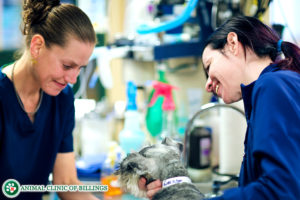Legg-calve-perthes disease
What is Legg-Calve-Perthes Disease?
Legg-Calve-Perthes Disease, also known as Avascular or Aseptic Necrosis of the Femoral Head, is a condition in which the head and neck of the femur (the “ball” of the hip joint) break down, causing degenerative joint disease and ultimately collapse of the hip joint.
What causes Legg-Calve-Perthes Disease?
This condition is caused by a major disruption in blood flow to the bone forming the head and neck of the femur. This appears to result from blood clots lodging in the vessels supplying these areas. The underlying cause of these blood clots is not yet known. As the bone-producing cells become deprived of oxygen and nutrients, tissue death (necrosis) occurs, ultimately resulting in structural breakdown of the femoral head and neck. It appears that genetics may play a role in this disease, as it has been observed to run in families in some breeds.
Which dogs are at risk for developing Legg-Calve-Perthes Disease?
Avascular Necrosis of the Femoral Head tends to occur primarily in dogs weighing less than 25 pounds. It is most commonly encountered in Terrier breeds and other toy and small breed dogs. Signs usually develop between 5 and 8 months of age, although they can emerge as early as 3 months of age or as late as 13 months. Because this appears to be a genetic condition, all dogs that develop this disease should not be bred.
What are the Signs of Legg-Calve-Perthes Disease?
Puppies with this disease tend to develop a gradually worsening limp in one of their hindlimbs. This may ultimately become severe enough that the puppy becomes unwilling to bear weight on the leg. In a minority of cases, the lameness appears to come on quite suddenly, and correlates with the collapse of the degenerating bone. Over a period of weeks to months, the affected leg loses muscle mass. Typically, the puppy will be very sensitive to attempts to handle their hip area and leg. While only one hip is usually affected, involvement of both hips has been reported in 10-15% of cases.
How is Legg-Calve-Perthes Disease Diagnosed?
The diagnosis of this disease is based on clinical signs, a physical exam, and x-rays. On exam, a loss of muscle mass and a decrease in range of motion of the hip joint are present. The affected limb may appear slightly shorter than the normal hind limb. X-rays of the pelvis and hips show flattening of the normally round surface of the femoral head, increased bone density (sclerosis) below the growth plate, and destruction (lysis) of the bone forming the femoral neck. Over time, the joint space widens and arthritic changes develop.
How is Legg-Calve-Perthes Disease Treated in dogs?
In a small percentage of cases with mild symptoms, conservative management with anti-inflammatory medications, weight management, and activity restriction proves sufficient in controlling the disease. The vast majority of cases, however, must be treated with surgery to restore comfort and limb function. The surgery most commonly used to address this disease is called a Femoral Head and Neck Ostectomy (FHO).
A Femoral Head and Neck Ostectomy involves removal of the head and neck of the femur. As the area heals following surgery, a fibrous false joint forms between the site of femoral neck removal and the hip socket (acetabulum). Following surgery, physical rehabilitation therapy to maintain hip range of motion and encourage early and consistent limb use is essential to a successful outcome. With appropriate after care, the outcome of this surgery is excellent, with most patients going on to use their leg completely normally without any residual discomfort.
Occasionally a total hip replacement may be recommended instead of an FHO. This is most often the case for larger dogs suffering from Legg-Calve-Perthes Disease and for patients affected by other hind limb orthopedic problems.
What is the Prognosis for Legg-Calve-Perthes Disease?
Following FHO surgery and post-operative physical rehabilitation therapy, most dogs have excellent pain-free limb function. A small percentage of dogs have a subtle residual asymmetry to their gait due to one leg being slightly shorter than the other, but this has minimal impact on their quality of life. Most dogs that undergo Total Hip Replacement also have an excellent outcome, and are able to return to full activity without any lingering discomfort.

Let our highly trained and experienced team of veterinarians and veterinary technicians help you keep your cat as happy and healthy as they can be.
Call the Animal Clinic of Billings and Animal Surgery Clinic to schedule your pet cat’s next wellness examination with one of our veterinarians today!
406-252-9499 REQUEST AN APPOINTMENT
ANIMAL CLINIC OF BILLINGS AND ANIMAL SURGERY CLINIC
providing our region’s companion animals and their families what they need and deserve since 1981
1414 10th St. West, Billings MT 59102
406-252-9499



